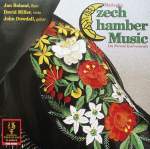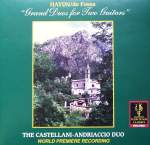 |
19th Century Chamber Music for Guitar
|
 |
(This document contains links that take you away from this site for
further reading. Some links will not work if you don't have Real Audio.
You need to press the "Back" button on your browser to return
to this article)
Two recent releases by the enterprising US label Fleur
de Son Classics help to illuminate the guitar's place in small-scale
chamber music at the start of the 19th century. On one disc are two original works
for flute, viola and guitar by Wenceslaus
(or Wenzel) Thomas Matiegka (1773 - 1830), while the
other contains arrangements by François de Fossa (1775 - 1849)
of three Haydn string quartets for guitar duo.
Before commenting on any reaction to the performances on these records,
it is worth reading about why these pieces were written in the first place,
and how it was that, for a while, Schubert was thought to have been the
composer of one of them. After 1780, the six-string instrument was becoming
universally accepted as a model for instrument makers (previously, our modern-day
low 'E'-string was omitted), and the composer-guitarists such as Fernando Sor and Mauro Giuliani
were spreading its fame outside Spain, most notably in Paris and Vienna.
Just as it does today, the instrument responded well to both elementary
and advanced performance technique, and found popularity in song accompaniment,
ensemble music, and solo works. Berlioz included the guitar in his Grande traité d'instrumentation et d'orchestration
modernes op.10 (1843), and pianists Hummel and Moscheles are known
to have performed in Vienna with Giuliani. The publication of a large number
of guitar tutors in the early 1800s could only have enhanced the instrument's
appeal to a wide tranche of both amateur and professional music-makers across
Europe.
Although Matiegka was born a Czech, and trained as a lawyer and keyboardist
in Prague, the fertile musical environment of Vienna attracted him to move
there around 1800, and by 1809 his accomplishments on both the piano and
the guitar had caused his publishers to label him a "piano and guitar
master". Indeed, with the great pool of piano-playing talent in the
city at this time, perhaps it was wise of Matiegka to focus his considerable
talent on the less famed of his instruments.
 His Nocturne
op.21 for flute, viola and guitar was printed in 1807, and might have
remained unknown to modern audiences had the 17-year-old Franz Schubert
not arranged it, in 1814, to add a cello part for his father. For some years,
it became famous as 'Schubert's Guitar Quartet' but is clearly listed in
Deutsch's catalog as 'D.96, Wenzel Matiekga's Notturno'. The young composer
made other additions, but this recording reverts to the original score,
of which only a single copy remains. It is a Nocturne only in name, being
a chamber work for evening performance, and not a descriptive piece in the
style of later piano works. Perhaps its most distinctive features are the
undeniable good humour that pervades all but one of its five movements (a
Lento e patetico middle movement is its one exercise in other emotions)
and His Nocturne
op.21 for flute, viola and guitar was printed in 1807, and might have
remained unknown to modern audiences had the 17-year-old Franz Schubert
not arranged it, in 1814, to add a cello part for his father. For some years,
it became famous as 'Schubert's Guitar Quartet' but is clearly listed in
Deutsch's catalog as 'D.96, Wenzel Matiekga's Notturno'. The young composer
made other additions, but this recording reverts to the original score,
of which only a single copy remains. It is a Nocturne only in name, being
a chamber work for evening performance, and not a descriptive piece in the
style of later piano works. Perhaps its most distinctive features are the
undeniable good humour that pervades all but one of its five movements (a
Lento e patetico middle movement is its one exercise in other emotions)
and  the Zingara, which is full
of Hungarian gipsy colours. A three-movement Serenade op.26,
in which the guitar introduces the main themes in both of the outer movements
(a measure of its importance), forms the opening to this disc. the Zingara, which is full
of Hungarian gipsy colours. A three-movement Serenade op.26,
in which the guitar introduces the main themes in both of the outer movements
(a measure of its importance), forms the opening to this disc.
In the recording of both of these works, the performers (Jan
Boland, flute, David Miller, viola, and John Dowdall, guitar)
have placed considerable and appropriate emphasis on historically informed
techniques. They use authentic instruments, not modern copies, and have
carefully researched the musical texts which have not survived well in the
hands of the 20th century publisher they name in their sleeve notes. Their
playing (notwithstanding very slight limitations caused by the instruments'
construction) leads to an entirely satisfying balance and causes me to recommend
this record to a collector seeking to enjoy undemanding but unusual late-Classical
repertoire. Sound quality is first class, too.
Upon investigating the Haydn/de Fossa record, it seemed to me that de
Fossa's life story has not yet given up all its secrets. New Grove
does not mention him, but research reproduced in the fascinating sleeve
notes (written by the editor of this music's modern-day edition) shows that
most of the arranger's career was spent in the militias of Spain and France.
When the army documents and his letters are finally combed thoroughly, perhaps
an exciting paper will be written about this man. A tantalising amount is
already known; he sailed to Mexico in 1796, was thrown into jail by the
French, but later joined their army and served with distinction until 1844.
He died in Paris in 1849. The disc's notes inform us that, until now, his
greatest claim to fame was that he aided the survival of several of Boccherini's
works, and translated from Spanish to French a guitar method by the famed
player Dionisio Aguado. We are told, however, that his work as an arranger
led to his being called 'The Haydn of the guitar'.
The scope and history of de Fossa's output again reveal much about the
musical practices of Europe at the start of the 19th century. His transcriptions
for guitar, which include operatic works as well as instrumental pieces,
were made from many sources of music. Not all were as authentic as he might
have wanted; some symphonies were available to him only as string quartet
arrangements and not orchestral scores. It is clear, however, that his publications
were intended mainly for advanced performers; the technique required for
the transcriptions recorded here makes no concessions to players with elementary
training only.
On this disc are selections from Haydn's early groups of quartets, op.2
and op.9. As with all of Haydn's first compositions, uncertainty surrounds
the circumstances of their writing. Though the op.2 quartets were published
around 1762-3, they may have been composed up to five years earlier, before
he became the Esterházy Kapellmeister. Op.9 may date from 1768-70
and, though it is entered in the catalogue Haydn kept for his employers,
the scholar Jens Peter Larsen suggests the quartets may either have been
written for amateurs or even for an Austrian monastery.
 While
none of the works ranks among the greatest quartets, each is written with
consistent invention and shares
a style of arrangement that fits well the capabilities of the guitar.
The performance by Joanne
Castellani and Michael Andriaccio (a premiere recording) is as flawless
as any can be, and I share the published wishes of While
none of the works ranks among the greatest quartets, each is written with
consistent invention and shares
a style of arrangement that fits well the capabilities of the guitar.
The performance by Joanne
Castellani and Michael Andriaccio (a premiere recording) is as flawless
as any can be, and I share the published wishes of  the
performers, that these
arrangements will be more widely played as legitimate chamber works
for guitar duo. The last piece on the disc, the five-movement op.2 no.1,
has the boldest nature, and perhaps should have been sequenced first. the
performers, that these
arrangements will be more widely played as legitimate chamber works
for guitar duo. The last piece on the disc, the five-movement op.2 no.1,
has the boldest nature, and perhaps should have been sequenced first.
For newcomers to the guitar duo as a chamber ensemble, the recorded sound
presents a hurdle. Although the closeness of the instruments to the microphone
does not cause the guitars to boom, the music does not appear to come from
a room beyond the loudspeakers but from the speakers themselves. 'Too many
strings, not enough music.' This is a pity, for the performances are worth
enjoying, even if one must sit in the next room to hear them without distraction.
Matiegka:
Czech Chamber Music
Wenceslaus Matiegka, Serenade op.26 and Nocturne op.21:
Jan Boland, flute, David Miller, viola, John Dowdall, guitar
(period instruments)
total time: 67'00", no producer credited, Peter Nothnagle, engineer/editor
FDS 57927
Grand
Duos for Two Guitars: The Castellani-Andriaccio Duo
Haydn / de Fossa, Grand Duos op.9, no.5 (Hob III:23), op.2 no.2 (Hob
III:8), op.2 no.1 (Hob III:7)
Joanne Castellani, Michael Andriaccio, guitars
total time: 71'12", produced by the artists
FDS 57922
|
I am The Author of this Book...
If you look up this book [Berlioz' Grande traité d'instrumentation
et d'orchestration modernes op.10 (1843)] on Amazon.com,
you might be amused by the link that reads:
- I am the Author, and I want to comment on my book.
There is no comment here, at present. Not even from "Richard Strauss
(contributor)". Meanwhile, here's a Fan
Page about Berlioz. |
Copyright © John Hayward-Warburton,
April 22nd 1999
More CD reviews >>
|